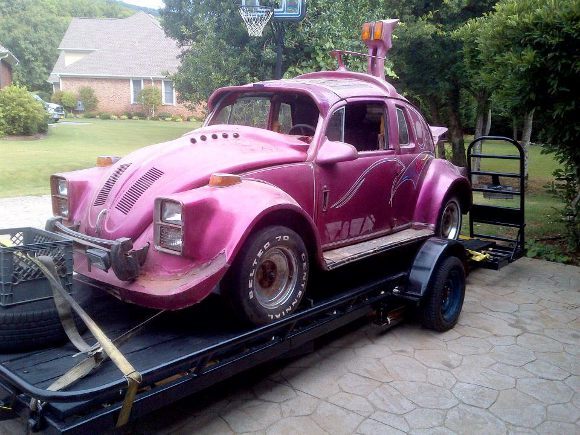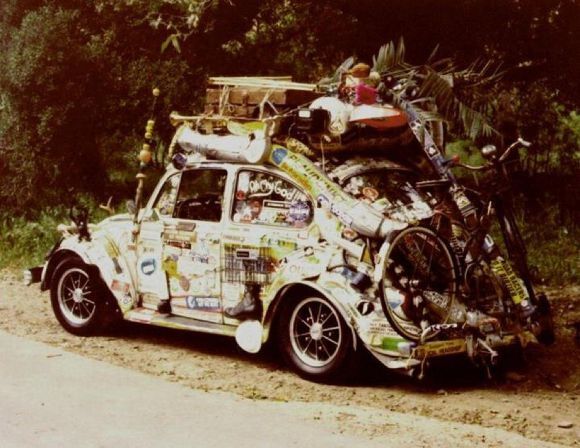Bug Art: Volkswagen Beetles Get the Tricked-Out Treatment

The dozen owners of weird, wild and wacky Volkswagen bugs that are part of the sprawling VW Classic in Irvine this weekend probably wouldn't be there if not for Adolf Hitler. It's one of the strangest of historical quirks, but arguably the world's most beloved car, one that, among its myriad uses can be used as a creative canvas, was shaped in no small fashion by one of the world's most atrocious human beings ever.
In 1934, Hitler, one year into his chancellorship of Germany, announced his desire to create an affordable car for ordinary Germans. He shared the idea with Ferdinand Porsche, who created a prototype and, in 1938, Hitler laid the cornerstone for the factory that would soon begin producing his "people's wagon," the Volkswagen.

The factory was bombed heavily during World War II, but most of the machinery survived and by 1949 it was back in business.
Though production would later shift to Mexico, the VW Type I which, by the end of the 1960s would be known as "the Beetle," took the world by storm. By 1972, VW claimed it had topped Ford's Model T as the world's most popular car; in 1981, the 20 millionth beetle rolled off a Mexican assembly line.
The car's weird shape, simplistic design and easily repairable machinery ingrained it into popular culture. "The Love Bug," a 1968 film starring a 1963 VW Beetle named Herbie would spark five more films. It surfaced in Woody Allen's 1973 film, "Sleeper," in which the car effortlessly started up after 200 years. The California surf culture and the flower power generation embraced it. Easily modified, the Beetle could be souped-up to drag racing status, and converted into off-road "Baja Bug" status.

And, even though the VW wasn't the world's first art-car, it has definitely made its presence known in that community.
"Art cars have been around since the birth of cars, actually even the horse and buggy," says Harrod Blank, one of the central figures in the art car movement. Now based in Arizona, the former Northern California-based Blank has written the definitive book on the art car movement, "Art Cars," and designed a few himself. "VW bugs lend themselves to being good canvases because they are inexpensive, are already unusual looking, and people love them and can't let go of them so they convert them into art cars."
None of Blank's fantastic cars, including his Pico De Gallo, which features dozens of playable musical instruments fastened to a driving VW beetle, will be on display in the 10th edition of the VW Classic's Freak Show. But his spirit of invention is not an oddity, the Beetle is a blank canvas for imaginative O.C. car lovers. A dozen or so of these mutated mobiles will be showcased at the show, many hand-picked by Randy Carlson, an Orange County native who launched the idea in 2002.

"The weird ones have always been my personal bent," said Carlson, who had a lifelong interest in working on cars. "After going to so many VW Shows for so long and realizing that all Beetles look fairly similar, I really loved finding or building something that was completely out of the box. So I decided to start a VW business that wasn't concerned as much with restoring something to its original condition, but creating really wacky and wild things, where you don't have to follow the rules, so to speak."
Carlson's garage, Old Bug, began in Brea. It's now in Temecula and you can see some of the trippy designs he's either found or built by visiting oldbug.com.
"It comes down to the simplicity of the design," Carlson said. "You can pull the body off and actually drive a running chassis and use that as a platform to build whatever you want. I've seen bodies made out of wood, or wrought-iron, or with sculptures and musical instruments sticking out of them. It really lends itself to whatever you want to create."

Each year, Carlson unveils a couple of new tricked-out bugs as part of the show, new in the sense that most people haven't seen one. This year, it's a pink concoction dubbed Snorkelstang, which is currently being shipped to Irvine.
"That's actually a legendary one that people have talked about for years," Carlson said. "But it kind of disappeared for a while and just resurfaced in February. So we're getting it out here so people can see it first-hand."
Making his fifth consecutive appearance at the Freak Show will be Laguna Beach resident Scott Alan and his 1961 rag-top bug beetle, which takes on a different appearance whenever the mood strikes him. One year, it was a Marvin the Martian theme. Last year, it was themed around the film Avatar. This year? It's a space dragonfly.

And if you don't think a tricked-out VW can't be considered a mobile piece of art, Alan would love to correct you.
"These things have been pieces of art since the hippies and surfers used them as canvases in the 1960s," said Alan, 57. He bought his bug in 1995 for a couple of hundred dollars. It needed a paint job and Alan had some friends who were graffiti artists and they offered to paint it if he supplied the materials. That launched him on an ongoing odyssey to convert his bug into whatever strikes his fancy.
"It's absolutely street art," said Alan, who staged an art car event in Santa Ana last October and hopes to do so again this year. "There is painting, sculpture, assemblage. And most of the stuff I put on my car are things that people have thrown away, like foam or mannequins, so there is a found art aspect as well."

The facts there were so many beetles purchased, and the shape has become so iconic, also influences people into visually tweaking them in some way, said Damon Claussen, who launched Rusty VW, a VW-related memorabilia and novelty item store last year in Burbank. "VW owners love their cars, whether they're restoring them to stock condition, turning into dragsters, or making them into works of art. And I think that's because VW's have touched most people in some way. Maybe it was someone's first car, or their older brother or dad drove one. It seems like a common thread through everybody, way less than six degrees of separation."

And while the people interviewed for this story are entrenched parts of the VW community, there's new people coming to the party every day. While taking a walk in my Fullerton neighborhood on Monday, I nearly stumbled into a wildly painted Beetle parked in front of Rutabegorz restaurant. I walked into the restaurant, asked around and discovered it was owned by a 25-year-old Orange Resident, Joseph Castro. It's a 1973 Beetle that he bought for $2,000 last year after his father, a mechanic, told him a client was looking to sell.
It was his first beetle. "I just fell in love with it," he said. He's met a couple of other VW owners and is slowly merging into the huge range of VW clubs scattered across Southern California.
As far as who painted the heady scene on his car, which, with its lightening-belching clouds, volcanoes, fish scales, suns, shadowy figures and such, looks more like a peyote-induced Carlos Castenada hallucination than a paint job, Castro doesn't know. The guy he bought it from had purchased it from someone else and the artist's name has been lost.
But this much Castro is sure of: the painter "must have been on acid or something."
Dig this story? Sign up for our newsletter to get unique arts & culture stories and videos from across Southern California in your inbox. Also, follow Artbound on Facebook, Twitter, and Youtube.







